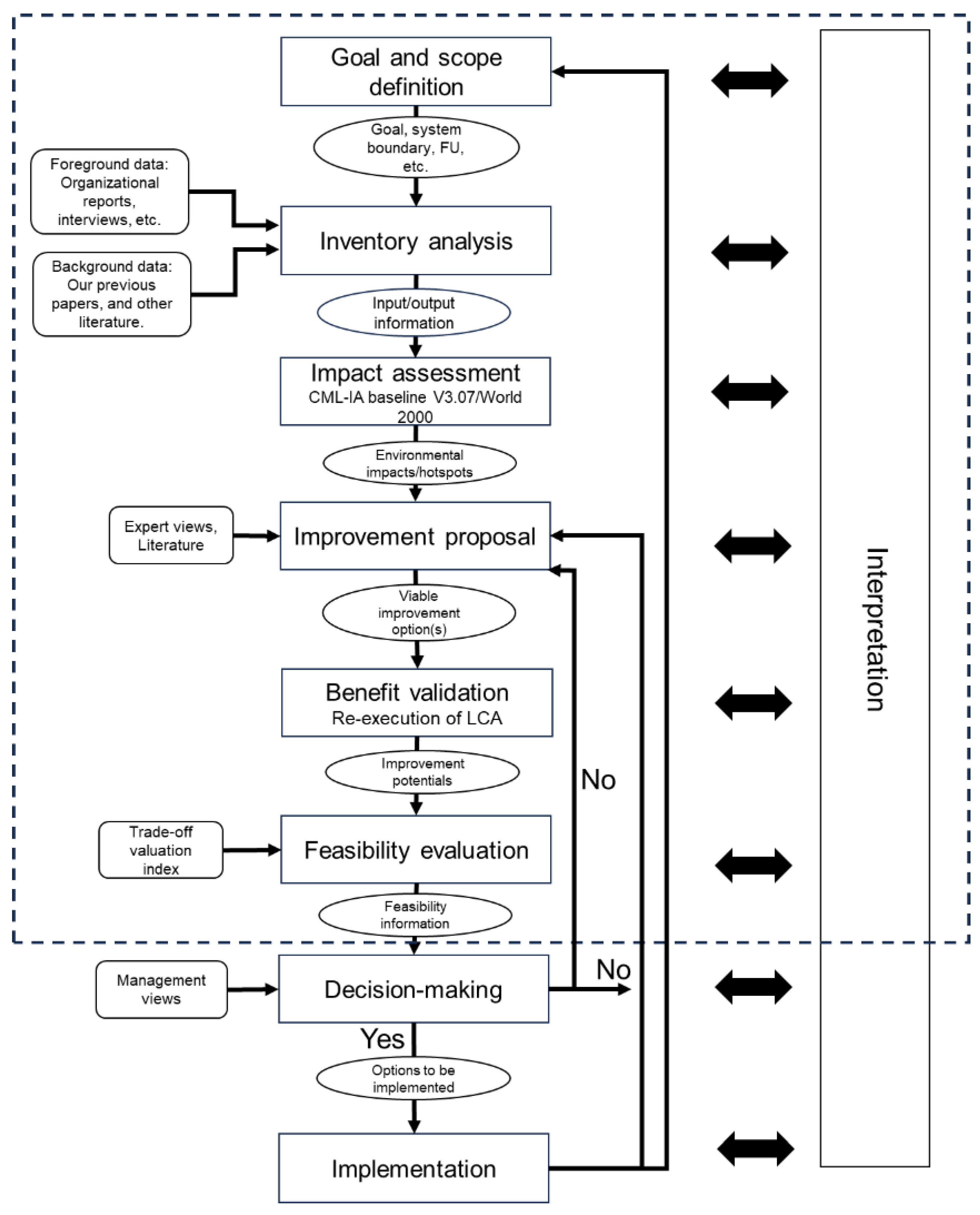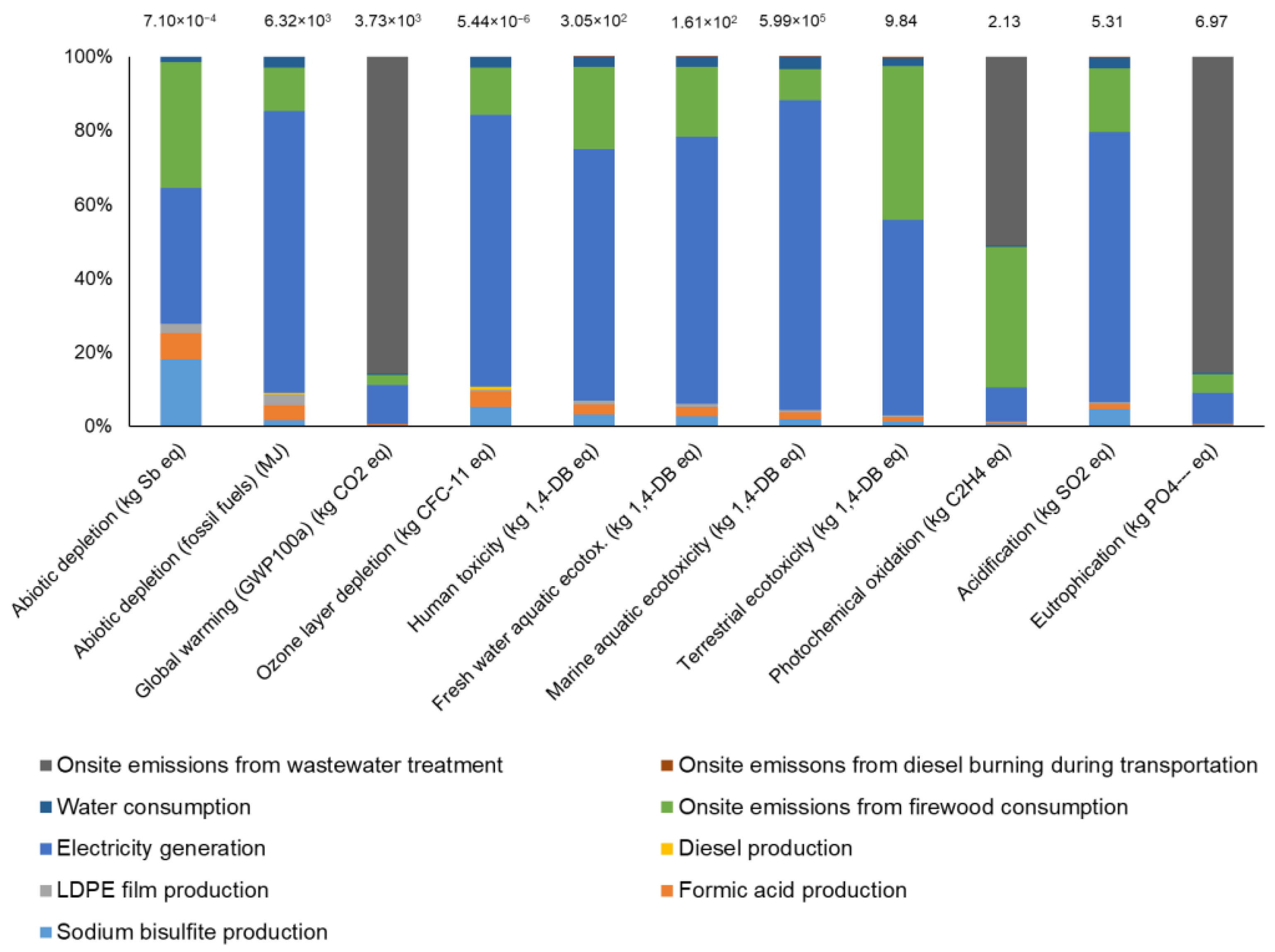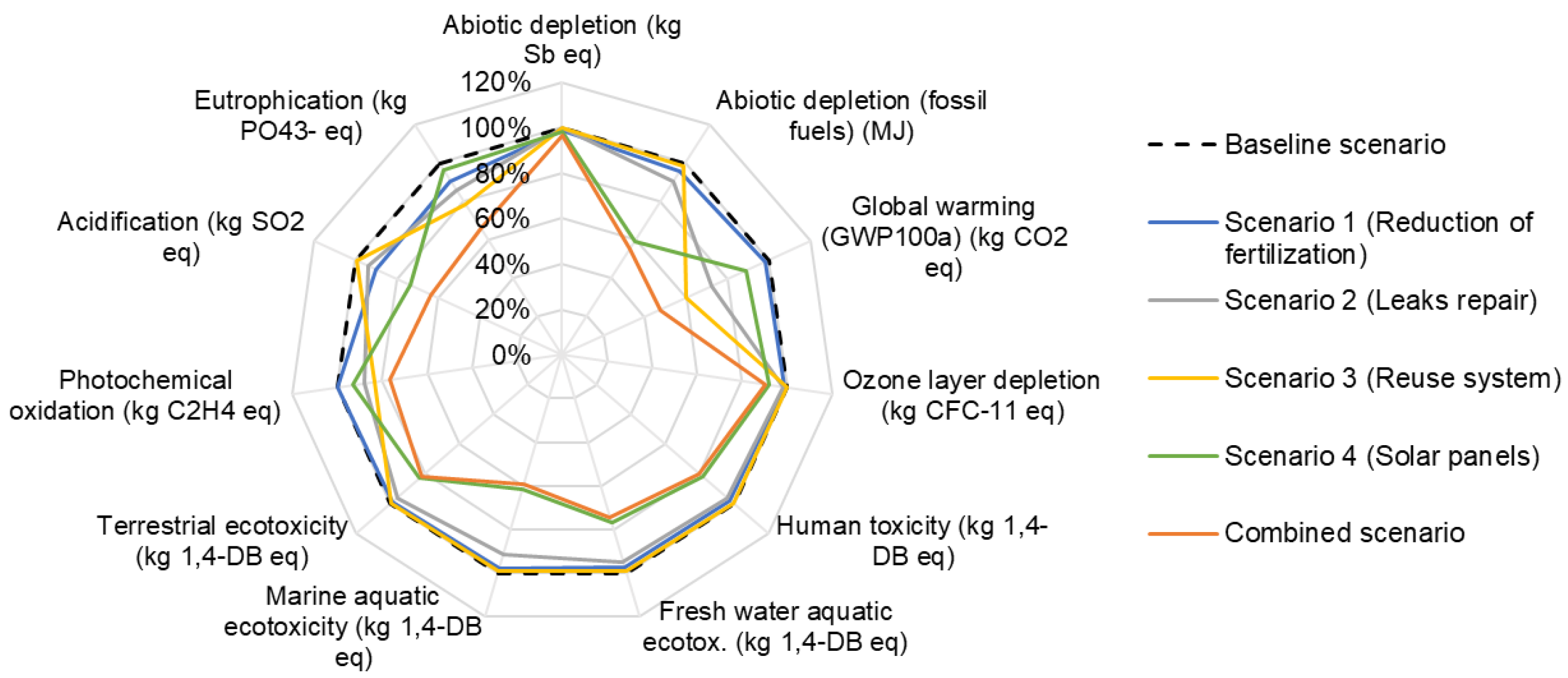Revealing the Environmental Footprint of Crepe Rubber Production: A Comprehensive Life Cycle Assessment of a Crepe Rubber Factory in Sri Lanka
Abstract
1. Introduction
2. Materials and Methods
2.1. Details of Rubber Cultivation
2.2. Crepe Rubber Production Process
2.3. The Framework of the Study
2.3.1. Impact Evaluation
- Goal and scope definition
- 2.
- Inventory Analysis
- 3.
- Data collection for rubber cultivation
- 4.
- Data Collection for Crepe Rubber Processing
- 5.
- Impact assessment
- 6.
- Interpretation
- 7.
- Sensitivity analysis
2.3.2. Improvement Proposal
2.3.3. Benefit Validation
2.3.4. Feasibility Analysis
2.3.5. Trade-Off Valuation Index
3. Results and Discussion
3.1. Impact Evaluation Results
3.2. Sensitivity Analysis
3.3. Proposal of Improvement Options
3.3.1. Option 1: Reduction in Fertilization
3.3.2. Option 2: Repair Leaky Joints and Valves and Fit Water Flow Meters
3.3.3. Option 3: Installation of Industrial Water Recirculation Cooling System
3.3.4. Option 4: Installation of Solar Panels
3.4. Evaluation of Potential Improvements
3.4.1. Option 1: Reduce Fertilization
3.4.2. Option 2: Repair Leaky Joints and Valves and Fit Water Flow Meters
3.4.3. Option: 3: Installation of Industrial Water Recirculation Cooling System
3.4.4. Option 4: Installation of Solar Panels
3.4.5. Combined Scenario
4. Conclusions
Supplementary Materials
Author Contributions
Funding
Institutional Review Board Statement
Informed Consent Statement
Data Availability Statement
Acknowledgments
Conflicts of Interest
References
- IHS Markit Rubber. Natural—Chemical Economics Handbook. Available online: https://www.ihs.com/products/natural-rubber-chemical-economics-handbook.html (accessed on 18 December 2017).
- Tillekeratne, L.M.K.; Nugawela, A.; Seneviratne, W.M.G. Handbook of Rubber; Vishva Lekha Printers: Ratmalana, Sri Lanka, 2003. [Google Scholar]
- Bengtsen, P. Behind the Rubber Label; Vishva Lekha Printers: Ratmalana, Sri Lanka, 2013. [Google Scholar]
- Sri Lanka Rubber Secretariat. Sri Lanka Rubber Industry Development Master Plan 2017–2026; Sri Lanka Rubber Secretariat: Battaramulla, Sri Lanka, 2017. [Google Scholar]
- Siriwardena, S. Proposed solar drying systems for crepe rubber drying. Bull. Rubber Res. Inst. Sri Lanka 2010, 51, 50–60. [Google Scholar]
- Dunuwila, P.; Rodrigo, V.H.L.; Goto, N. Sustainability of Natural Rubber Processing Can Be Improved: A Case Study with Crepe Rubber Manufacturing in Sri Lanka. Resour. Conserv. Recycl. 2018, 133, 417–427. [Google Scholar] [CrossRef]
- Dunuwila, P.; Rodrigo, V.H.L.; Goto, N. Financial and Environmental Sustainability in Manufacturing of Crepe Rubber in Terms of Material Flow Analysis, Material Flow Cost Accounting and Life Cycle Assessment. J. Clean. Prod. 2018, 182. [Google Scholar] [CrossRef]
- Peiris, S. Experiences of Cleaner Production Ewlementation in Rubber Industry and Potential For Future in Sri Lanka; 1997. Available online: https://www.semanticscholar.org/paper/EXPERIENCES-OF-CLEANER-PRODUCTION-EWLEMENTATION-IN-Peiris/7775ea377368910c0e9a01c55d66ef50ef8da5e3 (accessed on 31 October 2021).
- UNESCAP. Country Study on Sri Lanka Using Global Value Chain Analysis: The Industrial Rubber and Electronic Products Sectors; UNESCAP: Bangkok, Thailand, 2011. [Google Scholar]
- Edirisinghe, J. Community Pressure and Environmental Compliance: Case of Rubber Processing in Sri Lanka. J. Environ. Prof. Sri Lanka 2013, 1, 14–23. [Google Scholar] [CrossRef]
- Massoudinejad, M.; Mehdipour-Rabori, M.; Dehghani, M.H. Treatment of Natural Rubber Industry Wastewater through a Combination of Physicochemical and Ozonation Processes Citation: Massoudinejad M, Mehdipour-Rabori M, Dehghani MH. Treatment of Natural Rubber Industry Wastewater through a Combination of Physicoch. J. Adv. Environ. Health Res. 2015, 3, 242–249. [Google Scholar]
- Kumara, P.R.; Munasinghe, E.S.; Rodrigo, V.H.L.; Karunaratna, A.S. Carbon Footprint of Rubber/Sugarcane Intercropping System in Sri Lanka: A Case Study. Procedia Food Sci. 2016, 6, 298–302. [Google Scholar] [CrossRef]
- Tekasakul, S.; Tantichaowanan, M.; Otani, Y.; Kuruhongsa, P.; Tekasakul, P. Removal of Soot Particles in Rubber Smoking Chamber by Electrostatic Precipitator to Improve Rubber Sheet Color. Aerosol Air Qual. Res. 2006, 6, 1–14. [Google Scholar] [CrossRef]
- Dunuwila, P.; Rodrigo, V.H.L.; Goto, N. Improving Financial and Environmental Sustainability in Concentrated Latex Manufacture. J. Clean. Prod. 2020, 255. [Google Scholar] [CrossRef]
- Guinee, J.B. Handbook on Life Cycle Assessment Operational Guide to the ISO Standards. Int. J. Life Cycle Assess 2002, 7, 311–313. [Google Scholar] [CrossRef]
- Schrijvers, D.L.; Loubet, P.; Sonnemann, G. Developing a systematic framework for consistent allocation in LCA. Int. J. Life Cycle Assess 2016, 21, 976–993. [Google Scholar] [CrossRef]
- Dunuwila, P. Integration of Process Analysis and Decision-Making Tools for the Sustainability Improvements in Raw Rubber Manufacture. Ph.D. Dissertation, Toyohashi University of Technology, Toyohashi, Japan, 2019. [Google Scholar]
- Rubber Research Institute of Sri Lanka. Fertilizer for Rubber; Rubber Research Institute of Sri Lanka: Agalawatta, Sri Lanka, 2016. [Google Scholar]
- Dunuwila, P.; Rodrigo, V.H.L.; Goto, N. Assessing the Financial and Environmental Sustainability in Raw Rubber Processing; A Case Study with Ribbed Smoked Sheet Manufacture in Sri Lanka. Indones. J. Life Cycle Assess. Sustain. 2018, 2, 1–7. [Google Scholar] [CrossRef]
- ISO 14040:2006; Environmental Management—Life Cycle Assessment—Principles and Framework. The International Organization for Standardization (ISO): Geneva, Switzerland, 2006.
- Rubber Research Institute of Sri Lanka. Available online: https://www.rrisl.gov.lk/statistics_e.php (accessed on 10 May 2016).
- Dunuwila, P.; Rodrigo, V.H.L.; Daigo, I.; Goto, N. Social Impact Improving Model Based on a Novel Social Life Cycle Assessment for Raw Rubber Production: A Case of a Sri Lankan Rubber Estate. J. Clean. Prod. 2022, 338, 130555. [Google Scholar] [CrossRef]
- Khanali, M.; Mousavi, S.A.; Sharifi, M.; Keyhani Nasab, F.; Chau, K. Life Cycle Assessment of Canola Edible Oil Production in Iran: A Case Study in Isfahan Province. J. Clean. Prod. 2018, 196, 714–725. [Google Scholar] [CrossRef]
- Birnbach, M.; Lehmann, A.; Naranjo, E.; Finkbeiner, M. A Condom’s Footprint—Life Cycle Assessment of a Natural Rubber Condom. Int. J. Life Cycle Assess. 2020, 25, 964–979. [Google Scholar] [CrossRef]
- Jawjit, W.; Pavasant, P.; Kroeze, C.; Tuffey, J. Evaluation of the Potential Environmental Impacts of Condom Production in Thailand. J. Integr. Environ. Sci. 2021, 18, 89–114. [Google Scholar] [CrossRef]
- Dunuwila, P.; Rodrigo, V.H.L.; Daigo, I.; Goto, N. Social Sustainability of Raw Rubber Production: A Supply Chain Analysis under Sri Lankan Scenario. Sustainability 2023, 15, 11623. [Google Scholar] [CrossRef]
- Eggleston, H.S.; Buendia, L.; Miwa, K.; Nagara, T.; Tanabe, K. 2006 IPCC Guidelines for National Greenhouse Gas Inventories; IPCC: Kamiyamaguchi, Japan, 2006. [Google Scholar]
- Gamaralalage, D.; Sawai, O.; Nunoura, T. Effectiveness of Available Wastewater Treatment Facilities in Rubber Production Industries in Sri Lanka. Int. J. Environ. Sci. Dev. 2016, 7, 940–945. [Google Scholar]
- Frischknecht, R.; Rebitzer, G. The Ecoinvent Database System: A Comprehensive Web-Based LCA Database. J. Clean. Prod. 2005, 13, 1337–1343. [Google Scholar] [CrossRef]
- PRé Sustainability About SimaPro—SimaPro. Available online: https://simapro.com/about/ (accessed on 16 March 2023).
- Dunuwila, P.; Rodrigo, V.H.L.; Daigo, I.; Goto, N. Unveiling the Environmental Impacts of Concentrated Latex Manufacturing in Sri Lanka through a Life Cycle Assessment. Resources 2024, 13, 5. [Google Scholar] [CrossRef]
- Mahath, C.S.; Mophin Kani, K.; Dubey, B. Gate-to-Gate Environmental Impacts of Dairy Processing Products in Thiruvananthapuram, India. Resour. Conserv. Recycl. 2019, 141, 40–53. [Google Scholar] [CrossRef]
- Kumar, M.; Kumar Choubey, V.; Deepak, A.; Gedam, V.V.; Raut, R.D. Life Cycle Assessment (LCA) of Dairy Processing Industry: A Case Study of North India. J. Clean. Prod. 2021, 326, 129331. [Google Scholar] [CrossRef]
- Humbert, S.; De Schryver, A.; Bengoa, X.; Margni, M.; Jolliet, O. IMPACT 2002+: User Guide. 2012. Available online: https://www.quantis.com/pdf/IMPACT2002+_UserGuide_for_vQ2.21_30April2014a.pdf (accessed on 18 July 2024).
- Goedkoop, M. Eco-Indicator 95; PRé Consultants: Amersfoort, The Netherlands, 1995. [Google Scholar]
- EPD International. Environmental Performance Indicators; EPD International: Stockholm, Sweden, 2023. [Google Scholar]
- Gonçalves, J.; Freitas, J.; Fernandes, I.; Silva, P. Microalgae as Biofertilizers: A Sustainable Way to Improve Soil Fertility and Plant Growth. Sustainability 2023, 15, 12413. [Google Scholar] [CrossRef]
- Jawjit, W.; Kroeze, C.; Rattanapan, S. Greenhouse Gas Emissions from Rubber Industry in Thailand. J. Clean. Prod. 2010, 18, 403–411. [Google Scholar] [CrossRef]
- NewEarth B SHDB. Available online: http://www.socialhotspot.org/ (accessed on 31 October 2021).
- Sganzerla, W.G.; da Rosa, R.G.; Barroso, T.L.C.T.; Castro, L.E.N.; Forster-Carneiro, T. Techno-Economic Assessment of On-Site Production of Biomethane, Bioenergy, and Fertilizer from Small-Scale Anaerobic Digestion of Jabuticaba By-Product. Methane 2023, 2, 113–128. [Google Scholar] [CrossRef]
- Nesterenko, N.; Medeiros-Costa, I.C.; Clatworthy, E.B.; Cruchade, H.; Konnov, S.V.; Dath, J.P.; Gilson, J.P.; Mintova, S. Methane-to-Chemicals: A Pathway to Decarbonization. Natl. Sci. Rev. 2023, 10, nwad116. [Google Scholar] [CrossRef] [PubMed]





| Emission Source | Emission Factor | Characteristics |
|---|---|---|
| N2O direct emissions from fertilizer use (to air) | 0.1 | kg N2O-N/kg N use |
| N2O indirect emission after N leaching and runoff (to soil) | 0.00225 | kg N2O-N/kg N use |
| N2O indirect emission after emission of fertilizer N as NOx and NH3 (to air) | 0.001 | kg N2O-N/kg N use |
| CO2 direct emissions from Urea (to air) | 0.2 | kg CO2-C/kg urea |
| NH3 emissions from fertilizer use (to air) | 0.1 | kg NH3-N/kg N use |
| Direct NOx from fertilizer use (to air) | 0.21 | kg NOx/kg N2O from fertilizers |
| NO3− emissions from fertilizer use (to soil) | 0.3 | kg NO3−-N/kg N use |
| P emissions to water | 0.05 | kg P emissions/kg P use |
| Type of Conversion | Coefficients |
|---|---|
| kg CO2-C to kg CO2 | 44/12 |
| kg N2O-N to kg N2O | 44/28 |
| kg NH3-N to kg NH3 | 17/14 |
| kg NO3-N to kg NO3 | 62/14 |
| kg P2O5 to kg phosphorus | 62/142 |
| kg CO2-C to kg CO2 | 44/12 |
| Activity | Amount (kg Unless Mentioned) |
|---|---|
| Inputs | data |
| Urea | 79.36 |
| Rock phosphate | 70.45 |
| Muriate of potash (MOP) | 77.34 |
| Dolomite | 1.33 |
| Kieserite | 0.17 |
| Diesel for tillage | 13.68 L |
| Sodium sulfite | 1.38 |
| Herbicide (glyphosate) | 5.21 |
| Fungicides (tebuconazole) | 0.62 |
| Fungicides (hexaconazole) | 0.62 |
| Water (plantation protection) | 560 |
| Outputs (onsite) | |
| Field latex (dry rubber basis) | 1000 |
| N2O (to air) | 0.76 |
| NH3 (to air) | 3.99 |
| CO2 (to air) | 58.20 |
| NOx (to air) | 0.03 |
| P (to water) | 0.20 |
| Glyphosate (to soil) | 5.21 |
| Tebuconazole (to soil) | 0.62 |
| Hexaconazole (to soil) | 0.62 |
| Activity | Amount (kg Unless Mentioned) |
|---|---|
| Inputs | |
| Diesel for latex transportation | 167.18 |
| Field latex (dry/wet basis) | 1136.36/3130.23 |
| Sodium bisulfite | 4.90 |
| Formic acid | 4.30 |
| Bleaching agent | 1.22 |
| Electricity | 616.85 kWh |
| Firewood | 447.44 |
| LDPE film | 1.90 |
| Water | 87,034.09 |
| Outputs | |
| Crepe rubber (white) | 1000 |
| Yellow crepe | 136.36 |
| Rubber loss | 49.40 |
| Wastewater | 88,437.61 |
| Ash | 5.19 |
| Eminent emissions (on-site) | Eminent emissions (on-site) |
| CO2 (biogenic) (to air) | 1490.88 |
| CO2 (fossil) (to air) | 1.56 |
| CH4 (biogenic) (to air) | 108.74 |
| N2O (to air) | 0.44 |
| NOx (to air) | 1.24 |
| CO (biogenic) (to air) | 45.64 |
| CO (fossil) (to air) | 2.94 g |
| SO2 (to air) | 0.51 g |
| NO3− (to water) | 44.10 g |
| NMVOC, non-methane volatile organic compounds (to air) | 6.39 |
| Particulates, <2.5 μm (to air) | 1.37 |
| COD (to water) | 35.40 |
| BOD (to water) | 5.31 |
| NH4+ (to water) | 1.86 |
| Impact Category | Unit | Impact Value |
|---|---|---|
| Abiotic depletion | kg Sb eq | 1.76 × 10−2 |
| Abiotic depletion (fossil fuels) | MJ | 1.33 × 104 |
| Global warming (GWP100a) | kg CO2 eq | 4.53 × 103 |
| Ozone layer depletion (ODP) | kg CFC-11 eq | 3.78 × 10−5 |
| Human toxicity | kg 1,4-DB eq | 1.17 × 103 |
| Fresh water aquatic ecotoxicity | kg 1,4-DB eq | 5.48 × 102 |
| Marine aquatic ecotoxicity | kg 1,4-DB eq | 1.40 × 106 |
| Terrestrial ecotoxicity | kg 1,4-DB eq | 1.64 × 101 |
| Photochemical oxidation | kg C2H4 eq | 2.28 × 10 |
| Acidification | kg SO2 eq | 1.58 × 101 |
| Eutrophication | kg PO4--- eq | 1.64 × 101 |
| Impact Category | Unit | CML (Baseline) | IMPACT 2002+ | Eco-Indicator 95 | EPD (2013) |
|---|---|---|---|---|---|
| Global warming | kg CO2 eq | 4.525 × 103 | 1.806 × 103 | 2.299 × 103 | 4.531 × 103 |
| Ozone layer depletion | kg CFC-11 eq | 3.780 × 10−5 | 3.780 × 10−5 | 4.770 × 10−5 | 3.780 × 10−5 |
| Acidification | kg SO2 eq | 15.755 | 8.730 | 8.642 | 15.755 |
| Photochemical oxidation | kg C2H4 eq | 2.280 | 4.636 | 4.032 | 2.280 |
Disclaimer/Publisher’s Note: The statements, opinions and data contained in all publications are solely those of the individual author(s) and contributor(s) and not of MDPI and/or the editor(s). MDPI and/or the editor(s) disclaim responsibility for any injury to people or property resulting from any ideas, methods, instructions or products referred to in the content. |
© 2025 by the authors. Licensee MDPI, Basel, Switzerland. This article is an open access article distributed under the terms and conditions of the Creative Commons Attribution (CC BY) license (https://creativecommons.org/licenses/by/4.0/).
Share and Cite
Dunuwila, P.; Munasinghe, E.; Rodrigo, V.H.L.; Gong, W.T.; Daigo, I.; Goto, N. Revealing the Environmental Footprint of Crepe Rubber Production: A Comprehensive Life Cycle Assessment of a Crepe Rubber Factory in Sri Lanka. Sustainability 2025, 17, 1239. https://doi.org/10.3390/su17031239
Dunuwila P, Munasinghe E, Rodrigo VHL, Gong WT, Daigo I, Goto N. Revealing the Environmental Footprint of Crepe Rubber Production: A Comprehensive Life Cycle Assessment of a Crepe Rubber Factory in Sri Lanka. Sustainability. 2025; 17(3):1239. https://doi.org/10.3390/su17031239
Chicago/Turabian StyleDunuwila, Pasan, Enoka Munasinghe, V. H. L. Rodrigo, Wenjing T. Gong, Ichiro Daigo, and Naohiro Goto. 2025. "Revealing the Environmental Footprint of Crepe Rubber Production: A Comprehensive Life Cycle Assessment of a Crepe Rubber Factory in Sri Lanka" Sustainability 17, no. 3: 1239. https://doi.org/10.3390/su17031239
APA StyleDunuwila, P., Munasinghe, E., Rodrigo, V. H. L., Gong, W. T., Daigo, I., & Goto, N. (2025). Revealing the Environmental Footprint of Crepe Rubber Production: A Comprehensive Life Cycle Assessment of a Crepe Rubber Factory in Sri Lanka. Sustainability, 17(3), 1239. https://doi.org/10.3390/su17031239







